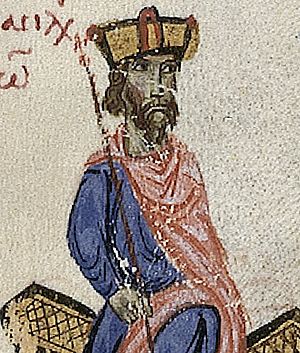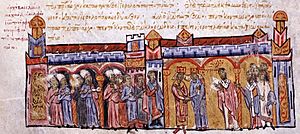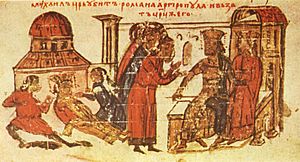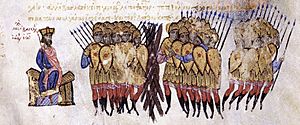Michael IV the Paphlagonian facts for kids
Quick facts for kids Michael IV the Paphlagonian |
|
|---|---|
| Emperor and Autocrat of the Romans | |

Michael IV, 11th century depiction from the Madrid Skylitzes
|
|
| Byzantine emperor | |
| Reign | 11 April 1034 – 10 December 1041 |
| Coronation | 12 April 1034 |
| Predecessor | Romanos III |
| Successor | Michael V |
| Co-regent | Zoë |
| Born | c. 1010 Paphlagonia (now Central Anatolia, Anatolia, Turkey) |
| Died | 10 December 1041 (aged 30–31) Monastery of the Holy Anargyroi, Constantinople (now Istanbul, Turkey) |
| Burial | Monastery of the Holy Anargyroi, Constantinople |
| Spouse | Zoë Porphyrogenita |
| Dynasty | Macedonian (by marriage) |
Michael IV the Paphlagonian (Greek: Μιχαὴλ (Δ´) ὁ Παφλαγών, Mikhaēl ho Paphlagōn; c. 1010 – 10 December 1041) was a Byzantine Emperor. He ruled from April 11, 1034, until his death on December 10, 1041.
Michael came from a simple family. He worked as a money changer before his brother, John the Orphanotrophos, helped him get a job at the imperial court. There, he met Empress Zoë Porphyrogenita. After her husband, Emperor Romanos III Argyros, died in 1034, Michael and Zoë were married. Michael was crowned emperor the very next day.
Michael was known for being handsome and full of energy. However, he had poor health, which meant his brother often handled much of the government's work. Michael did not fully trust Zoë. He took steps to make sure he would not face the same end as the previous emperor. The Byzantine Empire had mixed results during Michael's rule. His biggest success was in 1041. He led the army against rebels in Bulgaria. He returned victorious, but sadly, he died a few months later.
Contents
Becoming Emperor: How Michael IV Rose to Power
Michael grew up in a family of Greek peasants from a region called Paphlagonia. He moved to Constantinople, the capital city of the Byzantine Empire. There, he worked as a money changer.
One of Michael's brothers, John the Orphanotrophos, was a very important person at court. He was known as John the Eunuch. John held a high position called parakoimomenos. This meant he was in charge of the women's living areas in the palace. John helped several of his younger brothers get jobs at the court.
Romanos III Argyros became the emperor of the Byzantine Empire in 1028. He was not very good at ruling. Emperor Romanos III and his wife, Empress Zoë Porphyrogenita, did not have any children. This caused problems between them. Romanos started to ignore Zoë and limited her spending.
Zoë became interested in the young and handsome Michael. She even spoke openly about making him emperor. Romanos confronted Michael about this. Michael denied everything and swore he was innocent. Romanos believed him and allowed Michael to become his personal helper in 1033.
Emperor Romanos III became ill in early 1034. On April 11, Romanos was found dying in his bath. Zoë and Michael were married on the same day that Romanos III died. The next day, they asked the Patriarch Alexios I to crown the new emperor. Alexios first refused. But after receiving a large payment, he agreed. He crowned Michael as the new Emperor of the Romans, Michael IV.

Michael IV's Time as Emperor
Running the Empire: Michael's Domestic Policies
Michael IV was handsome, smart, and kind. However, he did not have much formal education and suffered from epilepsy. Because of his health, he often relied on others to help him run the government.
Empress Zoë thought Michael would be a more loving husband than Romanos. But Michael worried that Zoë might turn against him, just as she had turned against Romanos. So, he kept her out of politics. He made her stay in the palace's gynaeceum (women's quarters) and had her watched. Michael visited her less and less often.
Because of Michael's health and his concerns about Zoë, he let his brother John manage the government. John was already an important minister.
John made changes to the army and the financial system. These changes made the Empire stronger against its enemies. However, he also increased taxes. This made many people, both rich and poor, unhappy. John had a lot of power. New taxes, like the Aerikon (a land tax), led to several plots against him and Michael.
Bad weather and a locust plague in 1035 caused poor harvests and famine. This made people even more upset. There were revolts in places like Antioch, Nicopolis, and Bulgaria.
In 1034, Michael ordered the arrest of Constantine Dalassenos. He was suspected of planning a rebellion in Antioch. In 1038, Michael's brother, Constantine, stopped an uprising by soldiers in Anatolia. In 1040, a plot involved a priest named Michael Keroularios. He became a monk to save his life. Later, he became the Patriarch of Constantinople.
Protecting the Empire: Foreign and Military Affairs
At the start of Michael's rule, military matters were difficult. Arab pirates attacked Myra. The Serbs broke away from Byzantine control. The Pechenegs raided areas freely, even reaching the gates of Thessalonica.
But the situation soon improved. In the east, Arab pirates were caught or killed. The Byzantines captured the Muslim fortress of Berkri. This was on the eastern shore of Lake Van. The city of Edessa was saved after a long siege. It eventually became part of the empire in 1037.
In the west, Michael and John told their general, George Maniakes, to remove the Arabs from Sicily. In 1038, Maniakes landed in southern Italy. He quickly captured Messina. He then defeated Arab forces and took control of towns in the west and south of the island. By 1040, he had captured Syracuse. He almost drove the Arabs completely off the island.
However, Maniakes then had problems with his Lombard allies. His Norman soldiers were unhappy with their pay. They left the Byzantine general and started a revolt in Italy. This led to the temporary loss of Bari. Maniakes was about to fight them when John the Eunuch called him back. John suspected Maniakes of planning a rebellion. After Maniakes left, most of the land gained in Sicily was lost. An expedition against the Normans also faced several defeats, though Bari was later recaptured.
In the north, the Pechenegs initially forced the Serbs to seek protection from the Byzantine Empire. But in 1040, the Serbs revolted again, as did the Bulgarians. This uprising was partly due to high taxes. These taxes had to be paid in coin, not goods, which was a change for Bulgaria. The rebels wanted to bring back the Bulgarian state. They were led by Peter Delyan.
The rebels took Belgrade and declared Delyan the Emperor of Bulgaria. They quickly captured Skopje. Michael IV made things worse by removing the military governor (called a doux) of Dyrrhachium. This governor had been marching against Peter Delyan. Michael accused him of a plot. The governor's troops, who were mostly Bulgarian, joined the revolt. Delyan then began to attack Thessalonica. Dyrrhachium was lost. Delyan also defeated the Strategos (military governor) of Hellas. Most of the theme of Nicopolis also rebelled against Michael. They were unhappy with John the Eunuch's greed.
At this point, Michael's epilepsy caused him to be partly paralyzed. He also developed a severe case of dropsy. This made his legs swell and become infected. When he announced he would lead the army against the Bulgarians, his advisors were shocked.
In 1041, Michael set off for Macedonia with an army of 40,000 men. He was helped by Norse soldiers, including Harald III of Norway, who would later become a king. The Emperor gathered his forces at Mosynopolis and waited for the Bulgarian army. The Byzantines had an advantage because the Bulgarians were fighting among themselves.
Michael advanced, relieving Thessalonica. He then fought the Bulgarians, defeated them, and captured Delyan. Michael pushed his army deep into Bulgaria. The largest remaining Bulgarian group was at Prilep in a fortified camp. It was led by Manuel Ivats. The Byzantines attacked the camp, scattered the Bulgarians, and captured Ivats. The difficulties of the campaign brought Michael close to death. But he was able to return to Constantinople in triumph.
Michael IV's Final Days and Death

Despite his successful military campaign, it was clear that Michael was dying. He sought help from above by visiting the shrine of Saint Demetrius in Thessalonica. He also built or rebuilt many churches. In 1039, he gave money to every monk and priest in the empire. He also gave gifts to any parents who made him a godfather to their children.
John the Eunuch wanted to make sure he kept his power. So, he made Zoë adopt Michael's nephew, who was also named Michael. This nephew was their sister's son. After taking religious vows, Michael IV died on December 10, 1041. He refused to see his wife, who begged to visit him one last time. His nephew was then crowned emperor as Michael V.
See also
 In Spanish: Miguel IV para niños
In Spanish: Miguel IV para niños



